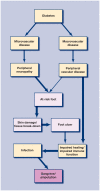Patients' perspectives on foot complications in type 2 diabetes: a qualitative study
- PMID: 18682014
- PMCID: PMC2566520
- DOI: 10.3399/bjgp08X319657
Patients' perspectives on foot complications in type 2 diabetes: a qualitative study
Abstract
Background: Foot ulceration is a major health problem for people with diabetes. To minimise the risk of ulceration, patients are advised to perform preventive foot self-care.
Aim: To explore beliefs about diabetic foot complications and everyday foot self-care practices among people with type 2 diabetes.
Design of study: Qualitative study using one-to-one interviews.
Setting: A suburban primary care health centre.
Method: Semi-structured interviews with a purposive sample of adults with type 2 diabetes but with no experience of foot ulceration.
Results: Most participants were unsure of what a foot ulcer is and unaware of the difficulties associated with ulcer healing. Prevention of accidental damage to the skin was not considered a priority, as few participants knew that this is a common cause of foot ulceration. Although it was recognised that lower-limb amputation is more common in people with diabetes, this was perceived to be predominantly caused by poor blood supply to the feet and unrelated to foot ulceration. Therefore, preventive foot care focused on stimulating blood circulation, for example by walking barefoot. Consequently, some of the behaviours participants considered beneficial for foot health could potentially increase the risk of ulceration. In some cases the uptake of advice regarding preventive foot care was hampered because participants found it difficult to communicate with health professionals.
Conclusion: Patients with type 2 diabetes may have beliefs about foot complications that differ from medical evidence. Such illness beliefs may play a role in foot-related behaviours that have previously been unrecognised. Health professionals need to explore and address the beliefs underlying patients' foot self-care practices.
Figures



Comment in
-
Diabetic feet.Br J Gen Pract. 2009 Apr;59(561):290. doi: 10.3399/bjgp09X420383. Br J Gen Pract. 2009. PMID: 19341560 Free PMC article. No abstract available.
References
-
- Jeffcoate WJ, Harding KG. Diabetic foot ulcers. Lancet. 2003;361(9368):1545–1551. - PubMed
-
- Kantor J, Margolis DJ. Expected healing rates for chronic wounds. Wounds. 2000;12(6):155–158.
-
- Pound N, Chipchase S, Treece K, et al. Ulcer-free survival following management of foot ulcers in diabetes. Diabet Med. 2005;22(10):1306–1309. - PubMed
-
- Ismail K, Winkley K, Stahl D, et al. A cohort study of people with diabetes and their first foot ulcer: the role of depression on mortality. Diabetes Care. 2007;30(6):1473–1479. - PubMed
-
- Oyibo SO, Jude EB, Tarawneh I, et al. The effects of ulcer size and site, patient's age, sex and type and duration of diabetes on the outcome of diabetic foot ulcers. Diabet Med. 2001;18(2):133–138. - PubMed
Publication types
MeSH terms
Grants and funding
LinkOut - more resources
Full Text Sources
Medical
Research Materials
